Abstract
The Avocent® Universal Management Gateway 6000 for IBM® is the first data center device that enables true, real-time, and integrated monitoring, access, and control across IT and facilities systems in the data center.
Note: This product has been withdrawn from marketing, effective August 31, 2015.
Introduction
The Avocent® Universal Management Gateway 6000 for IBM® is the first data center device that enables true, real-time, and integrated monitoring, access, and control across IT and facilities systems in the data center. The appliance makes it possible for data centers to have a unified approach to infrastructure management, resulting in greatly reduced cost and more efficient management and control.
The Avocent Universal Management Gateway (UMG) appliance serves as a single point for secure local and remote access and administration of target devices. The UMG supports secure remote data center management and out-of-band management of IT assets from any location worldwide.
The UMG appliance provides keyboard, video, and mouse (KVM) capabilities and can also remotely perform server management tasks, including power control and console access, on managed target devices. Multiple administrators can be logged in to the appliance at the same time and can use the web user interface (UI), the command-line interface (CLI), or DSView™ management software to access and configure the appliance.
The following figure shows the Avocent Universal Management Gateway 6000 for IBM.
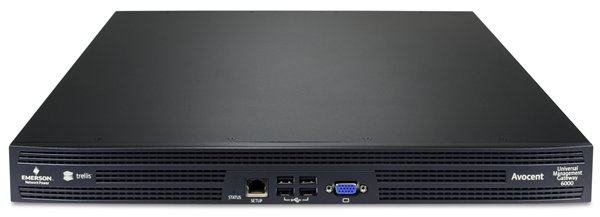
Figure 1. Avocent Universal Management Gateway 6000 for IBM
Did you know?
This rack-mounted appliance is a Data Center Infrastructure Management (DCIM) offering that enables you to have a single-pane view of physical space management, energy management, and asset management. Combined with Emerson Trellis™ and IBM Tivoli® software, the UMG appliance offers a common, real-time monitoring and management platform for all interdependent systems across IT and facility infrastructures.
Part number information
The following table shows the part numbers and feature codes for ordering the Avocent Universal Management Gateway 6000 for IBM.
Table 1. Part numbers and feature codes for ordering
| Description | Part number | Feature code |
| Avocent Universal Management Gateway 6000 for IBM | 3858D3X | None |
| UMG KVM Module VGA+SD Dual RJ45 (UMIQ Module) | 00AK142 | A4X4 |
The Avocent Universal Management Gateway 6000 for IBM includes the following items:
- Appliance Quick Installation Guide
- Mounting Bracket Quick Installation Guide
- Two power cords, C14 C13 10A/250V 2 meters
- RJ-45 to DB-9F cross adapter
- Mounting brackets and screws
- Safety and Regulatory Statements Guide
Figure 2 shows the rear of the Universal Management Gateway 6000.
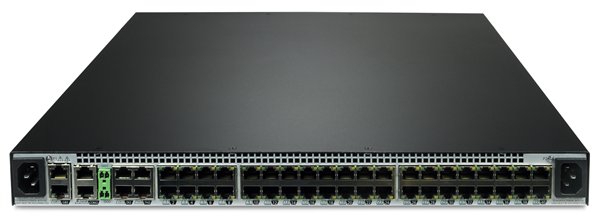
Figure 2. Ports at the rear of the Avocent Universal Management Gateway 6000 for IBM
Specifications
- 1U rack-mounted unit
- Front ports:
- VGA and USB 2.0 ports for local KVM console attachment
- USB ports also support smart card reader, CD, DVD, or mass storage devices.
- RJ-45 serial port for local setup (command-line interface for managing and configuring the appliance)
- Rear ports:
- 40 RJ-45 ports for serial, service processor, or KVM connections (auto-sensing)
- Management 10/100/1000 Ethernet ports for firewall, DSView, and authentication servers
- External sensor ports
- Supports up to 40 concurrent KVM sessions plus 20 additional shared sessions
- KVM sessions support enhanced video resolution up to 1600 x 1200 or 1680 x 1050 (widescreen) native from target to remote.
- Supports up to 1024 service processors
- Supports up to 10,000 data point collections
- AC Power: 100-240 VAC, 50/60 Hz, and 2 A
- Dimensions:
- Height: 43 mm (1.70 inches)
- Width: 434 mm (17.1 inches)
- Depth: 508 mm (20.0 inches)
- Weight: 6.4 kg (14.2 pounds)
- Operating environment:
- Temperature 0 to 50 °C
- Humidity 20 - 85% (non-condensing)
Features
The Avocent Universal Management Gateway for IBM is the converged management solution for complete data center access and monitoring.
- Simplified Remote Management
- Consolidated centralized access to racks/blades improves operational efficiency, freeing resources to focus on initiatives that generate higher business value
- Universal Connectivity
- Complete data center connectivity reduces complexity and accelerates IT standardization
- Real-Time Visibility and Control
- Managing assets from a single pane of glass in real-time enhances data center efficiency and enables better incident triage and quicker response
- Multi-Tenant Security
- Provides a secure environment improves compliance and auditing tasks for customers considering co-location and Cloud implementations
- Consolidated remote data center management
- Digital KVM
- Serial Console Management
- Service Processor Management
- Environmental Management
- Comprehensive “top of rack” integration capabilities
- LCD Access & LAN Access
- VGA KVM Control of servers
- Physical Power Control of any device
- Serial (RS232) Control of network switches, servers, and storage assets
- Server Control
- Embedded vKVM Control
- Embedded Power Control
- Embedded Serial over LAN
- Embedded Sensor Status
- Physical Environment Sensor Status
- Real-time monitoring logging and alerting
- Built-In Redundancy
- Dual power supplies, dual gigabit network cards and RAID 1 storage.
- Ease of Setup
- Web-based user interface designed for quick setup and configuration.
Secure access
You can securely access the appliance through the following local (analog console port) and remote (digital IP) options:
- Local analog KVM connection through the VGA and USB ports at the front of the UMG appliance
- USB ports
- Local serial console connection through the CLI
- Secure web UI using a network connection through TCP/IP
- Serial target device connection using Telnet, SSH v1, SSH v2, or a raw connection to a target device
Users and administrators can perform most tasks through the web UI (accessed with HTTPS). The web UI runs in Internet Explorer and Firefox browsers on any supported computer that has network access to the appliance. An administrator can use the web UI to create user accounts, authorize groups, and configure security and ports. Authorized users can access connected devices through the web UI to troubleshoot, maintain, cycle power, or to reboot connected devices, and change their password.
Service processor / IMM support
- Management through service processors and Integrated Management Modules (IMM)
- Supports a full range of service processors, including access through IPMI 1.5 and IPMI 2.0
- Supports service processors from multiple server vendors
- Service processor auto-discovery and auto-management
- Secure service processor access through the service processor browser UI and vKVM
- Local VGA console access to service processor sessions and data
- Granular permissions and clean UI presentation
Management through the serial console
- Serial data logging and alerting
- Soft pin-out support
- SSH to Serial pass-through
Management through KVM ports
- Non-blocking KVM support
- Connections use IP
- Full 100 m cable length support
- The UMG 6000 appliance supports up to 40 concurrent KVM sessions plus 20 additional shared sessions.
- Highly resistant to Electrical Magnetic Interference (EMI)
- Virtual media and CAC support
- Requires the usage of the UMIQ module, part number 00AK142 (one per server connection)
UMIQ-V2 module
The UMIQ module, part number 00AK142, is used to connect a server to the UMG appliance. The module has a VGA port, USB port, and one RJ-45 port to connect to the server (RJ-45 for the IMM service processor), and one RJ-45 port to connect to the UMG appliance. The module provides VGA/vMedia access and service processor access.
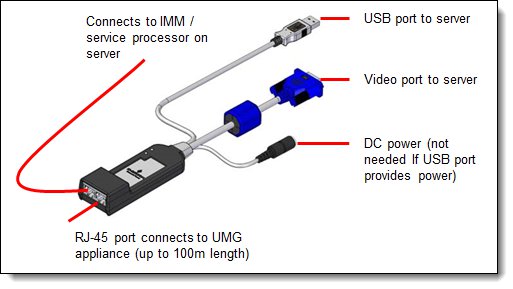
Figure 3. UMIQ-V2 module
The UMIQ module has an embedded Linux OS that boots when the UMIQ module has power. The UMIQ module requires full USB bus power to operate correctly. The DC power plug is useful for servers that do not provide sufficient power, for devices that lack USB interfaces, or for provisioning stations where the UMIQ module is moved regularly from one server to another.
While the UMIQ module has power from USB or DC, it is considered to be at full power and can maintain the secure IP connection with the appliance and KVM sessions with users. If the UMIQ module loses power but is still connected to the appliance, the UMIQ module requests that the appliance send standby power through the UTP cable to prevent the UMIQ module from going offline.
The UMIQ module running on standby power cannot support KVM sessions, but it can maintain its connection to the appliance. The UMIQ-v2 module can maintain the bridge between its two ports, ensuring that the SP is always accessible. The appliance uses the DC connector for all of its power needs and the USB plug is used only for data exchange. The appliance draws 5 V at 0.5 A from either DC or USB.
The UMIQ module offers a flash upgrade feature that allows the UMG appliance administrator to update UMIQ modules with the latest firmware available. UMIQ modules are automatically updated when the appliance is updated.
Control of virtual media and smart card-capable appliances
The UMG appliance allows you to transfer data on virtual media to and from any target device. Remote systems can be managed efficiently by allowing operating system installation or recovery, hard drive recovery or duplication, BIOS updating, and target device backup. Smart cards such as the Common Access Card (CAC) can be used to store identification and authentication to enable access to computers, networks, and secure rooms or buildings.
Virtual media and smart card readers can be connected directly by using USB ports on the appliance. In addition, virtual media and smart card readers may be connected to any remote workstation that is running the remote web UI or DSView management software and is connected to the appliance using an Ethernet connection.
Flexible users and groups
An account can be defined for each user on the appliance or on an authentication server. An administrator has an account by default and can add and configure other user accounts. Access to ports can be optionally restricted based on authorizations an administrator can assign to custom user groups.
Data logging, notifications, alarms, and data buffering
An administrator can set up data logging, notifications, and alarms to alert administrators about problems with email and syslog messages. An administrator can also store buffered data locally. Messages about the appliance and connected servers or devices can also be sent to syslog servers.
Power management
The UMG appliance enables users who are authorized for rack power distribution units (PDU) and service processor (SP) power management to turn on power on, turn off power, and reset servers through their embedded SP devices that are plugged into a connected rack PDU.
Auto discovery
An administrator can enable auto discovery to find the host name of a target that is connected to a port. Auto discovery’s default probe and answer strings have a broad range. An administrator can configure site-specific probe and answer strings. Auto discovery can also be configured through the DSView software.
IPv4 and IPv6 support
The appliance supports dual stack IPv4 and IPv6 protocols. The administrator can use the web UI or CLI to configure support for IPv4 and IPv6 addresses. The following IPv4 and IPv6 support is provided in the appliance:
- DHCP
- DSView software integration
- Ethernet interfaces eth0 and eth1
- Firewall (IP tables)
- HTTPS
- Linux kernel
- Remote authentication: AD and LDAP servers
- SSH and Telnet access
- Syslog server
Note: Remote authentication NFS, NIS, and IPSec are not supported by IPv6.
DSView management software
The DSView Remote Data Center Management (RDCM) software may be used with the UMG appliance to allow IT administrators to remotely access, monitor, and control target devices on multiple platforms through a single, web-based user interface. DSView software proxy and SSH Pass-through features enable convenient and secure remote access for LAN and WAN clients.
The following table lists the DSView software that is available from IBM.
Table 2. DSView part numbers
| Description | Part number | Feature code |
| Avocent DSView 3 Hub (100 Devices) | 46M5379 | 4170 |
| Avocent DSView 3 Standard Pack (500 Devices) | 46M5380 | 4171 |
| Avocent DSView 3 Plus Pack (2000 Devices) | 46M5381 | 4172 |
Trellis support
The UMG appliance works with the Trellis Data Center Infrastructure Management (DCIM) software from Emerson.
A modular solution that fits every sized company, the Trellis platform taps into servers, routers, storage, power distribution units, environmental monitors and more to intelligently aggregate, analyze and react to change and loads placed on environmental controls. And with the Avocent Universal Management Gateway appliance you can aggregate KVM, serial and service processor functionality with environmental and physical monitoring capabilities.
When combined with the Trellis platform, the Avocent Universal Management Gateway appliance efficiently discovers, collects and stores data from devices. The Trellis platform enables the user to easily perform trending, reporting and analysis.
Distinctive capabilities include:
- Real-Time Data Collection -- For businesses operating high-density environments, speed is critical. The appliance collects data from distributed environments and heterogeneous equipment (IT and facilities) in real time. Continuous streams of data are collected and aggregated in seconds by connecting natively to the device.
- Complex Event Processing -- Using a set of unique techniques and tools, the data collected by the appliance is filtered so that only relevant information is provided to a specific user. This processing helps the user to understand and control event-driven information systems.
Tivoli support
The Trellis Platform further fits in to the Tivoli portfolio:
- IBM Asset Management: Provision assets, view asset maintenance history, and issue work orders
- IBM Change Management: Generate an RFC, follow a change approval process, and update data in an asset repository and the Trellis platform
- IBM Service Catalog: A service request kicks off a space-planning initiative
- IBM Monitoring: Determine the optimal placement of a workload, and identify consolidation opportunities
- IBM Analytics: Intelligent data processing/analytics
- IBM Event Management: Event correlation, management, and automation
- IBM Business Service Management: Identify the potential business services that are impacted by MACs or data center events
Typical connections
The following figure shows how servers and sensors are connected to the UMG appliance, either through the UMIQ module or directly to the IMM service processor.
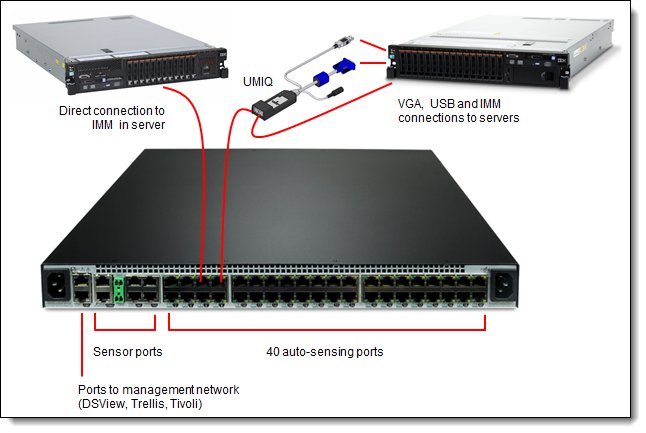
Figure 4. Connections to the UMG appliance
For local console access, the UMG appliance provides connections on the front of the unit, as shown in the following figure. The appliance supports local KVM access, including local CAC and USB media support and serial console access for setup and administration.
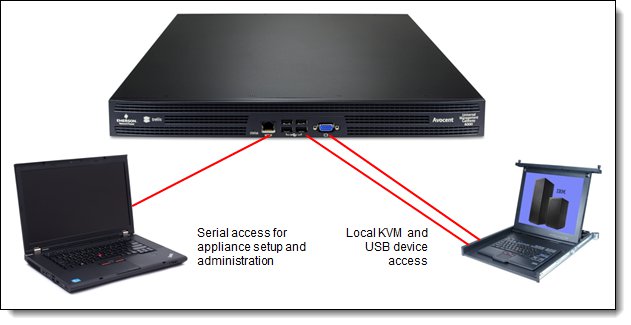
Figure 5. Local console access
Operating system support
This product runs in Microsoft Windows or Linux environments.
Warranty
The Avocent Universal Management Gateway 6000 for IBM has a three-year warranty. Customer Replaceable Unit (CRU) and IBM On-Site Repair (IOR) support is available, 8am - 5pm, Monday through Friday, next business day response.
Agency approvals
The Avocent Universal Management Gateway 6000 for IBM adheres to the following safety requirements:
- UL 60950-1:2007
- CUL
- FCC Part 15 Class A
- ICES-003 Class A
- CE
- EN55022 Class A
- EN55024
- EN61000-3-2
- EN61000-3-3
- C-Tick
- BSMI
- VCCI
- KCC
Related product families
Product families related to this document are the following:
Trademarks
Lenovo and the Lenovo logo are trademarks or registered trademarks of Lenovo in the United States, other countries, or both. A current list of Lenovo trademarks is available on the Web at https://www.lenovo.com/us/en/legal/copytrade/.
The following terms are trademarks of Lenovo in the United States, other countries, or both:
Lenovo®
The following terms are trademarks of other companies:
Linux® is the trademark of Linus Torvalds in the U.S. and other countries.
Microsoft®, Internet Explorer®, and Windows® are trademarks of Microsoft Corporation in the United States, other countries, or both.
IBM®, ibm.com®, and Tivoli® are trademarks of IBM in the United States, other countries, or both.
Other company, product, or service names may be trademarks or service marks of others.
